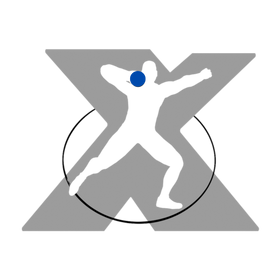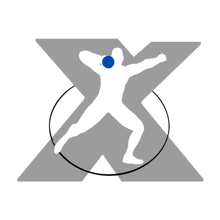Rotational Shot Put Technique
Rotational Shot Put
In the rotational shot put, the implement is placed at the base of the fingers, the thumb is under the ball to provide stability. The thrower places the shot firmly into neck with the elbow out and thumb down. Most rotational shot-putters place the ball either under or behind the ear; there are small variations, usually based on the comfort level of the athlete and the best position to maximize release speed by getting a strong ‘flick’ on the implement at the end of the throw (Throws University, 2020).
Start
The thrower faces the back of the circle with the feet shoulder width apart and the knees bent. The upper body will have some forward tilt, similar to the position in a back squat.
Both arms are elevated overhead in the starting position, then, the shot is placed above the right shoulder. The wrist is bent facing upward with the shot resting on the base of the fingers. The shot is then lowered onto the neck and placed just in front of the ear with the elbow out. The left arm is extended out, in-line with the center of the chest.
The shot put placement in the rotational shot put is different than the glide shot put. In the glide, the shot is placed near the chin with the elbow down to help keep the shot on a linear path.
To start the wind up, the upper body is rotated toward the right side, the change in weight distribution should be controlled during the wind up to develop consistency in the technique. The thrower should focus on rotating the upper body with minimal weight shift of the lower body. The rhythm of the throw is set up during the wind up, therefore a consistent acceleration pattern should be established. The rotational shot put requires very little wind up when compared to the discus throw. The wind up can cause problems with balance and consistency; therefore, a static start or a minimal wind up is recommended for novice throwers in the rotational shot put technique.

Rotational Movement
The body weight is shifted to the left leg and dropping the knee down over the toe then the right leg is picked up to start the momentum building phase of the throw. When the left foot reaches 90 degrees, the right leg is lifted up from the hip and knee. After the right foot is off the ground, the right side sweeps across the body, the knee and inside of the foot will lead the lower body.
A long, high sweeping action of the right leg around the outer edge of the circle will create a greater distance between the left foot and right toe during the sweep in the back of the circle, which will result in greater rotary momentum. During the sweeping movement, the left knee should be angle downward with the knee over the pushed over the toe. The upper body should remain level and passive with the left arm inside the left knee to maintain balance and create separation during the sweeping action in the back of the circle.
Drive to The Middle
After the right leg sweeps around the outside of the circle, the right foot drives across the ring into the middle of the circle. The right leg penetrates the ring with a powerful drive upward as it accelerates forward. The left leg should stay down with the knee bent, ready to push off toward the front of the circle as the right legs move toward the front of the circle. The shoulders should remain level during the drive to the middle; the shot stays behind the right hip and the left arm extended left arm while remaining inside the left knee.

Power Position Set Up
As the right leg moves past the middle of the ring, the right hip and foot should be pre-turned to set up the landing position. The left leg actively pushes off out of the back of the circle, the thrower will bring the knees together in the middle of the circle to help develop more velocity and create more torque in the power position. The shot remains behind the hip as the right foot touches down past the middle of the circle. The shot can rise up slightly into the middle of the circle, similar to the high point in the discus, just not as extreme. The left arm will drop down into the middle of the circle, slowing down the upper body creating additional separation from the lower body.
Into the Power Position
The right foot will make contact past the center of the circle between 280 to 340 degrees while the left foot is airborne near 90 degrees. Once the right foot has made contact, it must continue to rotate, turning on the ball of the foot. The left leg should be aggressively planted in the front of the circle. The shot should remain behind the right foot and the left arm should stay down until the left foot touches in the front of the ring.
Once the left foot touches down, the main acceleration phase of the throw begins. The largest gains in implement velocity occur after the thrower reaches the power position. Even in single support (one foot on the ground), the right side should keep turning; when the left foot plants, the right foot should be at approximately 90 degrees.
The acceleration of the shot and body movements during the preparation phase and momentum building phase set up an active throwing position to effectively apply force into the shot during the delivery of the throw.

Power Position
From the power position, the thrower actively turns and lifts the right side into the left leg block. As the right side lifts and turns toward the front of the circle while keeping the shot behind the hip. The left arm opens up to the center of the sector to set up the final blocking action of the left side during the release.
Most of the bodyweight should stay centered during the lifting and turning action prior to the release. The power position base is narrower in the rotational shot put but the same heel to toe relationship as in the glide shot put technique is performed to allow the hips to open up during the delivery phase.

Delivery
The right side of the body extends upward to complete the throw as the left side blocks. The thrower explosively lifts off the ground, the horizontal momentum created by driving across the ring is now converted into vertical velocity. The put is completed by lifting the shot upward then out over the toeboard; during the arm strike the elbow is high and the thumb is down. The left arm is pulled in toward the shoulder as the chest is driven up during the blocking action.
The vertical lift increases the height of release and sets up the recovery action after the release.
After the put is completed, the thrower will perform a reverse; bringing the right foot forward to the front of the ring after the shot is released. The right foot is planted flat and parallel throwing area, then the thrower can rotate around the right foot or execute other movements to stay in the ring. Corrective actions such as lowering the center of gravity or guiding the body away from the throwing sector can redirect the momentum of the thrower to assist with recovery after the release of the shot.



